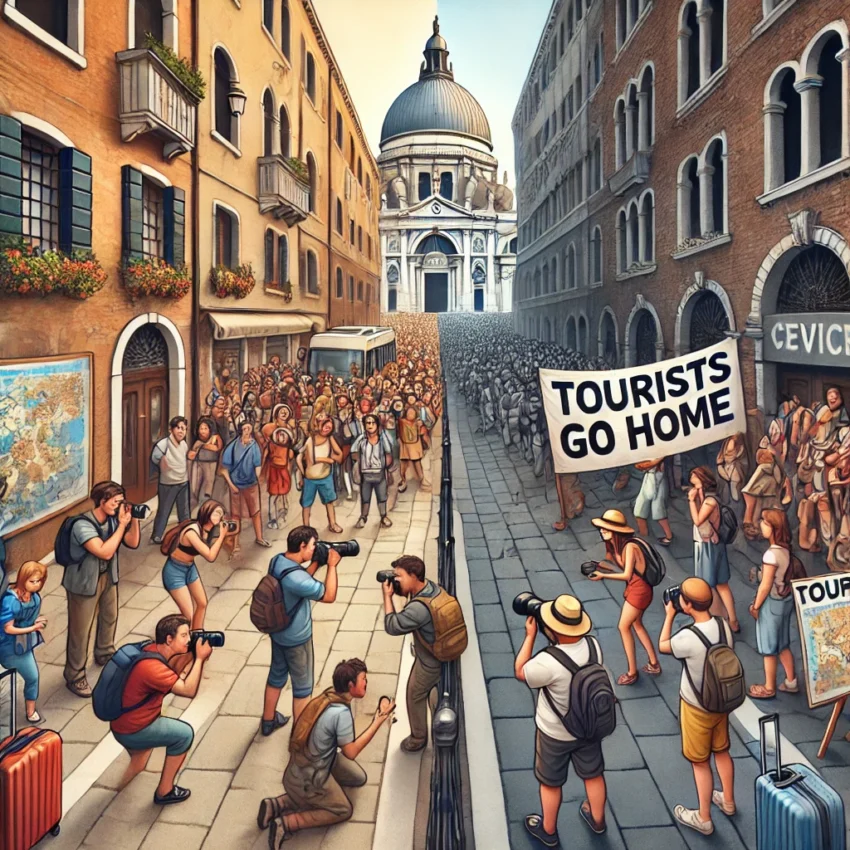Tourism has long been a double-edged sword, offering economic benefits while also exploiting local cultures and environments for profit. Although the recent backlash against mass tourism might seem like a new phenomenon, with protests and restrictions emerging globally in 2024, it is merely the latest chapter in a long history of friction between locals and tourists. These tensions have deep roots, and they underscore the need for a reevaluation of the role tourism plays in modern society.
The Historical Roots of Tourism Tensions
The origins of modern tourism date back to the 19th century when improved transportation made travel more accessible. Companies like Thomas Cook opened up destinations that were once exclusive to the aristocracy. However, this influx of visitors soon led to tensions as locals saw their traditional ways of life disrupted by the demands of the new tourist economy.
Even back then, a cultural snobbery emerged, distinguishing “travelers” from “tourists.” Travelers were seen as more cultured and respectful, while tourists were often viewed as disruptive and superficial. This attitude has only intensified over time, on both sides, with modern tourists seeing themselves as “travelers” while locals see them as tourists who think their shit doesn’t stink.
The Enduring Local Attachment
Data from the Pew Research Center reveals that nearly 37% of Americans have never left their hometown, highlighting a deep attachment to their homes and community. Another study highlights that the vast majority of younger Americans still live quite close to their homes, even if they have left its borders. This connection makes locals particularly sensitive to the disruptions caused by mass tourism. Whether in the 19th century or today, the arrival of tourists has often been met with a mix of economic dependence and cultural resistance.
In 2024, this resistance has taken various forms, from anti-tourist graffiti in Barcelona to Venice’s introduction of entry fees for day-trippers. Starting this year, Venice charges daytrippers up to €10 ($11) to enter the city. This fee is part of a broader strategy to manage the overwhelming number of tourists, protect the city’s fragile infrastructure, and preserve its cultural heritage.
While supporters argue that this fee is necessary to safeguard Venice, critics—ranging from social justice advocates to local business owners—see it as a barrier to accessibility, particularly for lower-income travelers. They argue that tourism has always been about profit, often at the expense of local communities, and that this fee further entrenches economic inequalities.
The Exclusion of Lower-Income Travelers and the Class Divide
For many lower-income travelers, even modest fees can be a significant barrier, effectively turning travel into a privilege for the wealthy. The Venice entry fee, when added to the already high costs of travel, could prevent many from experiencing the city’s cultural and historical treasures.Our modern society seems to think that “barriers” are inherently bad things, but the behavior of many of these people shows exactly why those barriers exist, and should be reinforced.
Lower income tourists, not travellers even in their own minds, come with lower-class behavior. Brawls? Check. Increased Crime? Check. Inability to pay for anything in the destination, because they spent all they had on the cruise? Check. The introduction of fees like Venice’s entry charge serves as a deterrent to this demographic, attempting to filter out those who are likely to detract from the experience of other visitors. It also serves to maintain the integrity of the destination, ensuring that those who visit are able to appreciate and support the cultural and historical treasures they are experiencing and also spread some of their wealth to the community they are visiting.
Rethinking the Role of Tourism: Redirecting Resources for Greater Impact
The global tourism industry is a financial powerhouse. In 2019, it generated approximately $1.7 trillion in export earnings, making it one of the largest industries in the world. The broader travel and tourism sector accounted for 10.4% of global GDP and supported 319 million jobs worldwide. In the United States alone, domestic and international tourism spending reached $1.1 trillion in 2022. These figures underscore just how deeply tourism is embedded in the global economy.
But what if we reconsidered the role of tourism in our lives? Instead of promoting more travel, we could encourage people to stay in their own countries and invest in their local communities. Redirecting even a fraction of global tourism expenditure—say, 10% or around $170 billion—could have a transformative impact on local economies.
Imagine the possibilities:
- Supporting Local Businesses: Redirecting tourism dollars to local businesses could create jobs and stimulate economic growth at the grassroots level. Small businesses are the backbone of many communities, and with increased investment, they could thrive, providing sustainable economic opportunities for residents.
- Improving Infrastructure: Many communities, particularly in rural or underdeveloped areas, suffer from inadequate infrastructure. Investment in these areas could fund essential projects such as building schools, hospitals, and transportation networks, dramatically improving the quality of life for residents.
- Preserving Cultural Heritage: Instead of exploiting cultural sites for profit, funds could be allocated to preserving and maintaining these sites. This approach would ensure that cultural heritage is protected for future generations, without the degradation caused by mass tourism.
- Promoting Sustainable Agriculture: With more resources directed toward local farmers and sustainable agriculture practices, communities could reduce their dependence on imported goods and enhance food security.
- Environmental Conservation: Large sums could be directed towards environmental conservation projects, protecting natural habitats from degradation and ensuring biodiversity for the future.
Conclusion: A New Approach to Tourism
The vast sums spent on tourism each year represent a significant opportunity for change. By encouraging people to stay in their own countries and invest locally, we could redirect these funds towards projects that have a lasting impact on communities, rather than contributing to the often exploitative and unsustainable practices of the global tourism industry. This shift could lead to more equitable and sustainable development, benefiting both local residents and the environment.
In conclusion, tourism has long been a source of tension between locals and visitors. As these tensions continue to escalate, it’s clear that we need to rethink the impact of tourism on our world. Rather than expanding tourism further, we should focus on protecting the places and people that are most vulnerable to its effects, ensuring that resources are used to build stronger, more resilient local communities.

